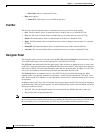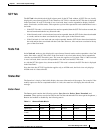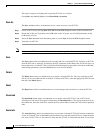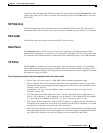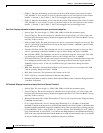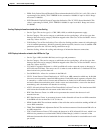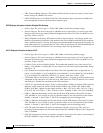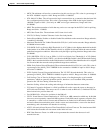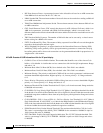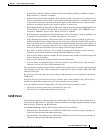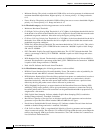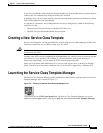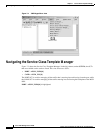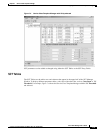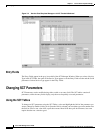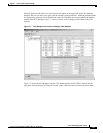
7-14
Cisco WAN Manager User’s Guide
Version 10.5, Part Number 78-12945-01 Rev. D0, August 2003
Chapter7 Service Class Template Manager
Functional Interaction
• RIF: Rate Increase Factor. A percentage increase in the allowable cell rate for an ABR connection
if the BRM cells do not have the N1 or C1 bits set.
• NRM: Number RM. The maximum number of data cells that can be sent before sending an RM cell
on an ABR connection.
• TRM: Time RM/Minimal Adjustment Period. The maximum amount of time between RM cells on
an ABR connection.
• CDF: Cutoff Decrease Factor. CDF controls the decrease in ACR (Allowed Cell rate), which is an
ABR service parameter, associated with CRM (Cell Rate Margin), which is a measure of the
difference between the effective bandwidth allocation and the allocation for sustainable rate in cells
per second.
• TBE:Transient Buffer Exposure. The number of RM cells that can be sent out by a virtual source
before waiting for a BRM cell in return.
• FRTT: Fixed Round-Trip Time. The amount of delay expected for an RM cell to travel through the
network to the destination and back again.
• WFQ: Weighted Fair Queuing is an approximation of the Generalized Processor Sharing (GPS)
scheduling. WFQ can be generally used to give performance guarantees to connections carrying
best-effort packet traffic, where each connection can be guaranteed bandwidth in proportion to its
weight and in a fair manner.
All CoSB: Presents all CoSB information within the VC panel display
• CoSB No: Class of Service Buffer Number. The number that identifies one of the sixteen Cosb
buffers. A Cosb buffer is a buffer that services connections with similar QoS requirements. Range
and units:1-16.
• Minimum Rate: Min Cell Rate (MCR): Set to default value. This field is not editable.
• Maximum Rate: Peak Cell Rate (PCR). Set to default value. This field is not editable.
• Minimum Priority: The priority at which this COSB will be serviced to guarantee it minimum and
maximum bandwidth requirements. Highest priority = 0; Lowest priority = 15. Range and units:
0-15.
• Excess Priority: The priority at which this COSB will be given access to excess bandwidth. Highest
priority = 0; Lowest priority = 15. Range and units: 0-15.
• Maximum Threshold:The VcMax Threshold for CLP (0+1) cells in microseconds. Range and units:
0-5000000 microseconds.
• CLP-HIGH: Cell Loss Priority High Threshold (% of VC QMax) is the highest threshold for the bit
in the header of an ATM cell that identifies the cell as eligible for discard within the network under
predefined congestion conditions. Most often set by the ingress policing function. Range and values:
0-1000000.
• CLP-LOW/EPD1: CLP (1) Low or EPDs (1): Cell Loss Priority Low Threshold (% of VC QMax)/
Early Packet Discard. If AAL5 FBTC = yes, then for the BXM card this is the EPD threshold setting.
EPDs is the lowest threshold for the bit in the header of an ATM cell that identifies the cell as eligible
for discard within the network under predefined congestion conditions.
• EPD0 Threshold: Early Packet Discard Threshold. The maximum threshold for CLP (0+1) cells.
This value is a percentage of the MAX_CELL THRESH for the connection. 1000000 is equal to
100%. Range and value: 0-1000000.
• EFCI Threshold: Explicit Forward Congestion Indication. The VC EFCI discard threshold. This
value is a percentage of MAX_CELL THRESH. 1000000 is equal to m100%. Range and values:
0-1000000.



